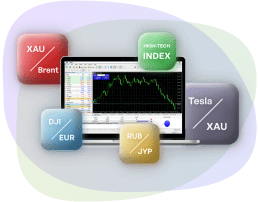- Education
- Learn to Trade Crypto
- How to Trade Cryptocurrencies
How to Trade Cryptocurrencies
The popularity of the cryptocurrency market has skyrocketed especially in the last couple of years, which has certainly contributed to the opportunities for traders to speculate on market prices. But before you open a position, it is important to know how to trade cryptocurrencies, so we have compiled a list of everything you will need to start trading.
The cryptocurrency market can be confusing for both novice and experienced traders due to the sheer amount of both jargon and processes. We have broken it down into simple steps to help you better understand the cryptocurrency trading.
But before that it's better to learn about what is crypto market.
How to Start Trading Cryptocurrency
Cryptocurrency trading is full of pitfalls. You can lose funds when buying bitcoin, holding and selling it, concluding transactions on the exchange and outside it. The question is where to start getting acquainted with a new type of asset, how to avoid losses and develop trading skills.
Digital money is gradually spreading around the world, thereby attracting new users. However, beginners may have many questions, the lack of answers to which can lead to financial losses and failure in this field of activity. We tell you how to avoid this and where to start getting acquainted with the crypto world.
Cryptocurrency Trading Steps
First things first
1. Open a Cryptocurrency Brokerage Account
Unless you already own cryptocurrency, you’ll need to make an account with a crypto brokerage, for example with IFC Markets. They offer BTC and ETH cryptocurrencies as well as CFDs on crypto futures.
To make an account, you’ll need to provide crypto brokerage of your choice with personal identification information, similarly to opening an account with a stock brokerage. Some common information you need to provide when setting up your account includes your Social Security number, address, date of birth and email address.
2. Obviously, fund your account
Once you have signed up with a crypto brokerage, you need to connect your bank account. Most crypto brokerage companies offer bank financing through debit cards and wire transfers. Bank transfer is usually the cheapest way to fund your account.
3. Choose a Platform to Trade on
The first choice is not always the best choice when figuring out where to trade crypto. For aspiring crypto day traders, the options and differences between many crypto exchanges can be overwhelming.
Here are the main points to consider when choosing the right trading platform:
- Years of activity - the longer the exchange works, the more chances it has for stability and trust.
- Supported Cryptocurrencies – knowing which cryptocurrencies are available for trading in advance can be a valuable tool when choosing a platform to use.
- Fees - transaction fees are what exchanges charge when buyers or sellers make a trade. All cryptocurrency exchanges charge users a transaction fee to monetize their business. The structure of the transaction fee may vary depending on the exchange's strategy, such as not charging fees on trades above $10,000 to encourage large-scale trades.
- Deposit methods - as with brokerage companies, users need to fund their exchange account with capital. Many exchanges allow wire transfers and wire transfers, but few allow credit card top-ups, transfers via PayPal.
- Liquidity - The liquidity of an exchange means both the speed and ease of access to the exchange when converting one asset to another without affecting its price. The best crypto exchanges are highly liquid, meaning they can buy or sell assets almost immediately and with minimal difference between the buy and sell prices.
- User reviews - Visiting various crypto communities and reading user reviews is one of the best ways to evaluate which exchange to choose.
4. Choose Crypto to Invest in
Once you've decided on a platform, it's time to choose what you want to invest in. For cryptocurrency day traders, market volatility is a necessary evil. The same market condition that discourages buy-and-hold investors is the chaos that creates profit opportunities for day traders. Volatility and liquidity are two elements that an intraday trader needs to actively participate in the cryptocurrency market.
Note: when choosing what to invest in, consider asset liquidity, volatility and trading volume.The liquidity of an asset is a measure of how easily an asset can be converted into cash without affecting its price. The BTCUSD price or ETHUSD price can change when a trader executes a trade and an exchange executes an order.
The difference between these prices is slippage, and in the crypto markets, a few minutes can mean the difference between a big profit or a big loss. A lack of liquidity can be disastrous for the entire crypto market, causing slippage and increasing the risk of an instant collapse.
Traders proactively try to close their positions as soon as possible, and in the absence of buy orders, the price of an asset can plummet.
The most active cryptocurrency traders invest most of their capital in bitcoin and Ethereum. These cryptocurrencies move more predictably than smaller altcoins, so trading with technical indicators can be easier.
Many crypto traders allocate some of their capital to smaller altcoins. Although small mid market cap cryptocurrencies are riskier than large market cap cryptocurrencies, they offer higher upside potential. Many smaller altcoins have surged over 1,000% in a few months, making them attractive to risk-tolerant investors.
5. Choose a Cryptocurrency Trading Strategy
There are many methods that day traders use to profit from short-term fluctuations in the cryptocurrency markets. A crypto day trader must develop a winning strategy based on research, with well thought out plans for when to open and close their positions.
For potential intraday traders, some websites allow users to track and copy the most successful traders on the trading platform. Below are some of the most popular trading strategies in crypto day trading.
6. Consider bot trading
Trading bots implement a strategy that is designed to give you the best results based on your investment goals. Because automated trading can provide you with a conservative, neutral, or aggressive method, traders can quickly make money, hold your coins, or diversify your portfolio.
A trading bot is an automated software tool that investors use to buy and sell financial instruments at pre-configured times or when predefined conditions are met to maximize profits. Cryptocurrency trading bots are designed to increase profits and reduce losses and risks.
Cryptocurrency trading bots can make it easier to monitor price movements, exchange fees, and short-term profit opportunities from trades. For decades, bot trading software has been a staple of stock exchange brokerages. Traders versed in software programming and APIs should definitely use this to their advantage as intraday traders. You can also consider actively trading cryptocurrencies on some platforms while using automated trading on others.
7. Store your cryptocurrency
When you are trading cryptocurrencies, you’ll have to store your funds on the exchange to have access to them. If you’re buying your cryptocurrency to hold for the mid to long term, then you should get a cryptocurrency wallet. Cryptocurrency does not have the same types of protection as money in a bank account or investments made through a broker. As the owner, you are responsible for holding the cryptocurrency.
Note: If you lose access to your cryptocurrency, it will most likely disappear.
There are several types of wallets to consider when you are deciding on crypto wallets. Let’s have a look.
Custodial wallet
A custodial wallet can be considered as the default option for storing cryptocurrencies. A third party stores your cryptography for you in either cold (offline) or hot (online) storage, or a combination of the two.
Main Pros
- It requires the least amount of work on the user's part.
- Since your crypto is stored in your account, it's easy to access if you want to trade it.
- No need to worry about losing a crypto wallet. As long as you can access your account, you can access your crypto.
Cold Wallet
- Every hardware wallet has certain types of cryptocurrencies that it can store.
- When you connect your hardware wallet to your computer, you can generate an address to receive cryptocurrencies into your wallet.
- You can send crypto from your wallet to another crypto address.
- Every hardware wallet has a recovery phrase. This phrase allows you to recover your crypto if you lose the device itself. It is important to keep this safe because anyone who has it can take your cryptocurrency.
Hot Wallet
- They give you control over your cryptocurrency.
- They are almost always free.
- They are easy to use. You can send and receive cryptocurrencies very quickly with this type of wallet.
Physical Wallet
A physical crypto wallet, also known as a paper wallet, is another type of cold storage. A paper wallet is a printout of a public and private key, usually in the form of a string of characters and scanned QR codes.
These keys are how you make transactions with cryptocurrency. You receive cryptocurrency with a paper wallet using public keys. To send crypto from your wallet, you need to scan the public and private keys.
Here are a few tips for you for storing cryptocurrencies:
- Keep most of your cryptocurrency in a cold wallet as this is the safest option.
- Use a hot wallet for small amounts of cryptocurrencies that you want to use for trading.
- Physically record the recovery phrases for your crypto wallets. You can write them down, and there are also steel tools designed to write down cryptographic recovery phrases.
- Save your recovery phrases in a safe place that only you can access.
- Never give your crypto wallet recovery phrase or private keys to anyone and do not save them to your computer.
Crypto FAQs
What is Cryptocurrency Trading?
Cryptocurrency trading is the exchange of digital currency between traders. The fluctuations caused by supply and demand allow traders to profit from it. Cryptocurrency trading is both risky and rewarding due to its volatility.
How to Trade Cryptocurrencies?
You’ll need to open an account with a crypto brokerage company. The next step is to choose a trading platform. After that choose crypto to invest in and strategy to trade with. Final step is to store your cryptocurrency.
Can you Trade Crypto 24/7?
Yes. Cryptocurrency markets are open 24 hours a day, 7 days a week all year round. Traders have the opportunity to buy and sell without restrictions as the cryptocurrency markets do not close.
What are Most Traded Cryptos?
These are the 5 most traded cryptos all over the world
- Bitcoin - Market cap over $846 billion
- Ethereum - Market cap over $361 billion
- Tether - Market cap - over $79 billion
- Binance Coin - Market cap - over $68 billion
- XRP - Market cap - over $37 billion
What is Cryptocurrency Market?
Cryptocurrency is a form of decentralized currency and It's a completely digital asset. At its core, cryptocurrency uses blockchain technology to generate code segments that are unique for each transaction, just like serial numbers. Every time cryptocurrencies exchange hands, code segments are written to a decentralized ledger.





